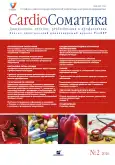Reduced progression of atrial fibrillation in hypertensive patients with long-term treatment of propafenone
- Authors: Tarzimanova A.I1, Podzolkov V.I1
-
Affiliations:
- I.M.Sechenov First Moscow State Medical University of the Ministry of Health of the Russian Federation
- Issue: Vol 7, No 2 (2016)
- Pages: 24-28
- Section: Articles
- URL: https://journals.rcsi.science/2221-7185/article/view/45218
- DOI: https://doi.org/10.26442/CS45218
- ID: 45218
Cite item
Full Text
Abstract
Full Text
##article.viewOnOriginalSite##About the authors
A. I Tarzimanova
I.M.Sechenov First Moscow State Medical University of the Ministry of Health of the Russian Federation
Email: tarzimanova@mail.ru
канд. мед. наук, доц. каф. факультетской терапии №2 лечебного фак-та ГБОУ ВПО Первый МГМУ им. И.М.Сеченова 119991, Russian Federation, Moscow, ul. Trubetskaia, d. 8, str. 2
V. I Podzolkov
I.M.Sechenov First Moscow State Medical University of the Ministry of Health of the Russian Federationд-р мед. наук, проф., зав. каф. факультетской терапии №2 лечебного фак-та ГБОУ ВПО Первый МГМУ им. И.М.Сеченова 119991, Russian Federation, Moscow, ul. Trubetskaia, d. 8, str. 2
References
- Guidelines for the management of atrial fibrillation. The Task Force for the Management of Atrial Fibrillation of the European Society of Cardiology (ESC). Eur Heart J 2010; 31 (19): 2369-429.
- Benjamin E.J, Levy D, Vasiri S.M. Independent risk factors for atrial fibrillation in a population - based cohort: the Framingham Heart Study. JAMA 1994; 271: 840-4.
- Holmqvist F, Kim S, Steinberg B.A et al. Heart rate is associated with progression of atrial fibrillation, independent of rhythm. Heart 2015; 101: 894-9.
- De Vos C.B, Pisters R, Nieuwlaat R et al. Progression from paroxysmal to persistent atrial fibrillation. JACC 2010; 55 (8): 725-31.
- Im S.I, Chun K.J, Park S.J et al. Long - term prognosis of paroxysmal atrial fibrillation and predictors for progression to persistnt or chronic atrial fibrillation in the korean population. J Korean Med Sci 2015; 30 (7): 895-902.
- Миллер О.Н., Старичков С.А., Поздняков Ю.М. и др. Эффективность и безопасность применения пропафенона (пропанорма) и амиодарона (кордарона) у больных с фибрилляцией предсердий на фоне артериальной гипертонии, ишемической болезни сердца и хронической сердечной недостаточности с сохраненной систолической функцией левого желудочка. Рос. кардиол. жур. 2010; 4 (84): 56-72.
- Тарзиманова А.И., Подзолков В.И., Лория И.Ж., Мохаммади Л.Н. Изменение сократимости миокарда у больных артериальной гипертензией и фибрилляцией предсердий при лечении пропафеноном. Доктор.ру 2012; 6 (74): 20-3.
- Подзолков В.И., Тарзиманова А.И. Пропафенон в лечении нарушений ритма сердца. Кардиология. 2012; 5 (52): 70-3.
- De Vos C.B, Breithardt G, Camm A.J et al. Progression of atrial fibrillation in the REgistry on Cardiac rhythm disORDers assessing the control of Atrial Fibrillation cohort: clinical correlates and the effect of rhythm - control therapy. Am Heart J 2012; 163: 887-93.
Supplementary files







